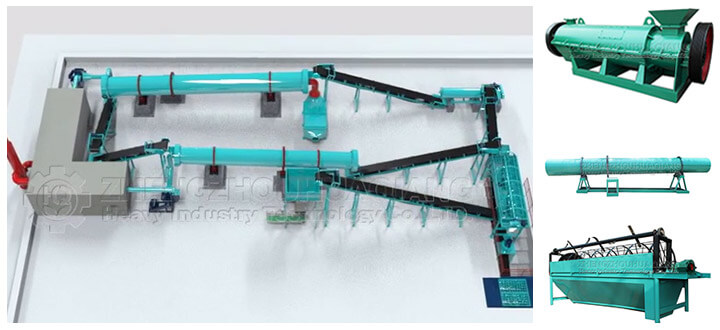With the popularization of organic fertilizer equipment, there is an optimal treatment method for manure produced in the aquaculture industry. We can process it into organic fertilizer through organic fertilizer equipment, thereby promoting the development of our agriculture. Generally, due to the funding chain, many friends in the aquaculture industry can choose small organic fertilizer equipment, and small organic fertilizer production lines can still effectively carry out pollution-free treatment of livestock and poultry manure. In fact, organic fertilizer equipment with an annual output of less than 20000 tons belongs to small-scale organic fertilizer production lines.
1. Stack manure and other materials, household garbage, sludge, and other fertilizer making base materials in strips on a flat ground (trough type dumper directly puts the materials into the trough). The stacking width is equal to the stacking width of the equipment, the height should be as high as possible, and the length should be as long as possible, such as 50 meters, 100 meters, etc. The ground should be flat, and both cement and land can be used (as long as they are flat and have a certain hardness). Each 10000 tons of production requires 5 to 6 acres of land, and the floor area of the slot type tipping machine will be relatively small.
2. Sprinkle composting base materials such as piled livestock and poultry manure and other materials, household garbage, sludge, etc. with biological fermentation bacteria (our unit provides technology and fermentation bacteria).
3. Use a tilter or trough type tilter to evenly mix straw, livestock and poultry manure, other materials, household garbage, sludge, (water content should be between 50% and 70%), fermentation bacteria, and other materials. After 3 to 5 hours, deodorization can be achieved. After 16 hours, the temperature rises to 50 degrees Celsius, and when the temperature reaches 55 degrees Celsius, the tilter again increases oxygen. In the future, when the temperature of the material reaches 55 degrees Celsius, the tilter begins to stir, playing the role of uniform fermentation, oxygen enrichment, and temperature reduction, Repeat the next process until thoroughly decomposed.
4. If the water content of livestock and poultry manure and other materials, household garbage, sludge, etc. is too high, it is possible to add auxiliary materials that contain organic matter and are relatively dry and can absorb water, or use the method of reflux to place the last dried fertilizer below to form a choppy shape. Place the livestock and poultry manure and other materials, household garbage, sludge, etc. with a high water content in the middle, allowing the water above to seep into the bottom before dumping.
5. The general composting process takes 7-10 days, but due to different climates in different regions, it may take 10-15 days for the material to fully mature, realizing the characteristics of no odor, no bacteria, insect eggs, weed seeds, high humus content, and high potassium content.
6. Then, equipment such as pulverizers, grading screens, and automatic packaging machines can be used to pack powdered organic fertilizers for warehousing and sales. If it is to produce powdery organic fertilizer, it can be sold on the market after the completion of the above advanced process. However, considering inventory time, fertilizer efficiency maintenance, etc. as a commodity sale, it is necessary to further process the above process into granular organic fertilizer. It is necessary to further process the above process into granular organic fertilizer.
Environmentally friendly small organic fertilizer equipment is supported by the state and enjoys financial subsidies. It has the characteristics of convenient material collection, low cost, fast recovery cost, low energy consumption, good income generation efficiency, no pollution, and high organic content, and can effectively create conditions for improving the soil environment, improving the living environment of farmers, and soil water pollution.